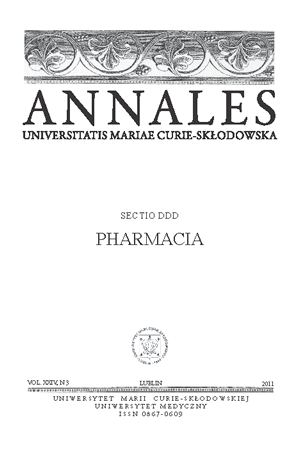Ocena wybranych parametrów biochemicznych surowicy krwi szczurów poddanych działaniu simwastatyny, doksepiny lub ich kombinacji
DOI:
https://doi.org/10.12923/Słowa kluczowe:
simwastatyna, doksepina, parametry biochemiczneAbstrakt
W pracy oceniano wpływ łącznego 14-dniowego i.p. podawania szczurom simwastatyny i doksepiny na wybrane parametry biochemiczne w surowicy krwi świadczące o funkcji wątroby. Oznaczano aktywność AST i ALT oraz stężenie białka całkowitego i AFP. Na podstawie otrzymanych wyników stwierdzono, że 14-dniowe podawanie szczurom simwastatyny w kombinacji z doksepiną powoduje zwiększenie aktywności aminotransferaz, zwiększenie stężenia AFP oraz zmniejszenie stężenia białka całkowitego w odniesieniu do grup otrzymujących te leki pojedynczo. Na podstawie uzyskanych wyników wydaje się jednak, że łączne stosowanie simwastatyny i doksepiny wymaga systematycznej kontroli parametrów świadczących o funkcji wątroby. Dane te mogą być pomocne w terapii tymi lekami.
Bibliografia
Boottorf M.: Statin safety and drug interactions: clinical implications. Am J Cardiol, C27, 97, 2006.
2. Bottorf M.: “Fire and forget?” – pharmacological considerations in coronary care. Artherosklerosis, 23, 147, 1999.
3. Chalasani N.: Statins and hepatotoxicity: focus on patients with fatty liver. Hepatology, 41, 690, 2005.
4. Charles E.C.et al.: Evaluation of cases of severe statin-related transaminitis within a large health maintenance organization. Am J Med, 618, 118, 2005.
5. Chug E., Nafziger A. N., Kazierad D. J., Bertino J. S.: Pharmacokinetic and drug disposition. Comparison of midazolam and simvastatin as cytochrome P450 3A probes, Clinical Pharmacology and Therapeutics, 79, 350,2006.
6. Cohen D.E. et al.: An Assessment of Statin Safety by Hepatologists. Am J Cardiol, S77, 97, 2006.
7. Cohen D.E. et al.: An Assessment of Statin Safety by Hepatologists. Am J Cardiol, S77, 97, 2006.
8. Downs J.R. et al.: Primary prevention of acute coronary events with lovastatin in men and women with average cholesterol levels: Results of AFCAPS/TexCAPS. J Am Med Assoc, 1615, 279, 1998.
9. Dujovne C. A.: Side effects of statins: hepatis versus „transaminitis” – myositis versus „CPKitis”. Am J Card, 1411, 89, 2002.
10. Hawton K. et al.: Toxicity of antidepressants: rates of suicide relative to prescribing and non-fatal overdose. B J Psych, 196, 354, 2010.
11. Heerey A. et al.: The potential for drug interaction with statin therapy In Ireland. Ir J Med Sci, 176, 3, 2003.
12. Herman R.J.: Drug interactins and the statins. CMAJ, 161 9100, 1281, 1999.
13. Jacobson T.A.: Statin Safety: Lessons from New Drug Applications for Marketed Statins. Am J Cardiol, 97, S44, 2006.
14. Karnik N.S., Maldonado J.R.: Antidepressant and statin interactions: a review and case report of simvastatin and nefazodone-induced rhabdomyolysis and transaminitis. Psychosomatics, 565, 46, 2005.
15. Kiortisis D. N. et al.: Statin-associated adverse effects beyond muscle and liver toxicity. Atherosclerosis, 7, 195, 2007.
16. Lakshmanan M., et al.: Effective low dose tricyclic antidepressant treatment for depressed geriatric rehabilitation patients: A double-blind study. Journal of the American Geriatrics Society, 421, 6, 1986.
17. Mach T.: Statyny a ryzyko uszkodzenia wątroby. Przegląd Gastroenterologiczny, 111, 2, 2007.
18. Mahley R.W., Bersot T.P.: Drug therapy for hypercholesterolemia and dyslipidemii. In: Goodman, Gilman, editors. The pharmacological basic of therapeutics, Medical Publishing Division, 971, 2001.
19. Marttila M. et al.: A double-blind study comparing the efficacy and tolerability of mirtazapine and doxepin in patients with major depression. Eur Neuropsychopharmacol, 441, 5, 1995.
20. Mitchell D.B., Acosta D.: Evaluation of the cytotoxicity of tricyclic antidepressant in primary cultures of rat hepatocytes. J. Toxicol. Environ. Health, 7, 83, 1981.
21. Paoletti R., Corsini A., Bellosta S.: Pharmacological interaction of statins. Atherosclerosis, (Suppl. 3), 35, 2002.
22. Patassini S., Giampa C., Martorana A., Bernardi G., Cusco FR.: Effect of simvastatin on neurorotection and modulation of Bcl-2 and BAX in the rat quinolinic acid model of Huntington´s disease, Neurosci Lett, 19, 166, 2008.
23. Rudorfer M.V. et al.: Comparative tolerability profiles of the newer versus older antidepressants. Drug Safety, 18, 10, 1994.
24. Smith C. et al.: Screening for Statin-Related Toxicity: The Yield of Transaminase and Creatine Kinase Measurements in a Primary Care Setting. Arch Intern Med, 688, 163, 2003.
Pobrania
Opublikowane
Numer
Dział
Licencja
Prawa autorskie (c) 2011 Autorzy

Praca jest udostępniana na licencji Creative Commons Attribution-NonCommercial-NoDerivatives 3.0 Unported License.


